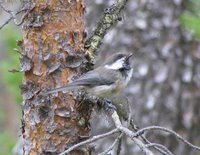Saturday, August 05, 2006
Lapintiainen vähenee - Siberian tit is becoming less common
 Lapintiainen (Parus cinctus) on Itä-Lapin erämaaseutujen ympärivuotinen perustiainen. Se on Värriön luonnonpuistossa silti verraten harvinainen. Sen kevätkanta (jolloin kanta on alimmillaan talvipakkasten jälkeen ja jolloin lintulaskennat tehdään ennen pesintää) puistossa lienee vain noin 50 lapintiaisparia.
Lapintiainen (Parus cinctus) on Itä-Lapin erämaaseutujen ympärivuotinen perustiainen. Se on Värriön luonnonpuistossa silti verraten harvinainen. Sen kevätkanta (jolloin kanta on alimmillaan talvipakkasten jälkeen ja jolloin lintulaskennat tehdään ennen pesintää) puistossa lienee vain noin 50 lapintiaisparia.Laulultaan hiljaisen lapintiaisen havainnointi luntulaskentojen aikaan antanee sen yleisyydestä aliarvion. Lapintiaisen huomaa verrattomasti useammin elokuun alussa, kun laululinnut ovat hiljenneet, osa muuttajia on lähtenyt jo vaellukselleen. Lapintiaisen poikueet tirskuttavat silloin muuten hiljaisessa metsässä, kuten kuvan lähes lopullisen värityksensä saanut poikanen Kotovaaran tutkimusmännikössä.
 Pitkäaikaisten (1985-2006) pistelaskentojen perusteella lapintiainen näyttää vähenevän Värriön luonnonpuistossa. Havaintojen tulkintaa vaikeuttaa niiden yllättävä vähyys; useina vuosina yhtään lapintiaista ei ole sattunut vakiopisteisiin.
Pitkäaikaisten (1985-2006) pistelaskentojen perusteella lapintiainen näyttää vähenevän Värriön luonnonpuistossa. Havaintojen tulkintaa vaikeuttaa niiden yllättävä vähyys; useina vuosina yhtään lapintiaista ei ole sattunut vakiopisteisiin.Ilmeistä kuitenkin on, että jos joku Itä-Lapin pohjoisista erämaalinnuista väistyy ilmaston vähittäisen lämpenemisen myötä, lapintiainen kuuluu niiden lajien joukkoon.
Siberian tit (Parus cinctus) belong to the basic round-the-year bird stock in Varrio Nature Reserve. It is rather rare, however, especially in early summer when the regular bird counting is done. We must remember that the small tit suffers from heavy winters and the stock is at its lowest just before the nesting. The nesting stock may be as low as 50 pairs only.
Siberian tit is ny nature quite silent and it easily disappears in the early summer concert in the wilderness. The total stock based on bird countings may thus be underestimate. It is much easier to see the Siberian tits in August when the chicks have already grown up and they let phoptographer to come near, like the one in the picture did in Kotovaara forest.
Based on thye long-term bird counts the stock of Siberian tit seems to be in slight sinking trend. The interpretation of the trend suffers from the few observations. In several years not a single Siberian tit happened to be in the regular observation spots.
It is probable, however, that if some specii suffer from warming summers, Siberian tit belongs to those.